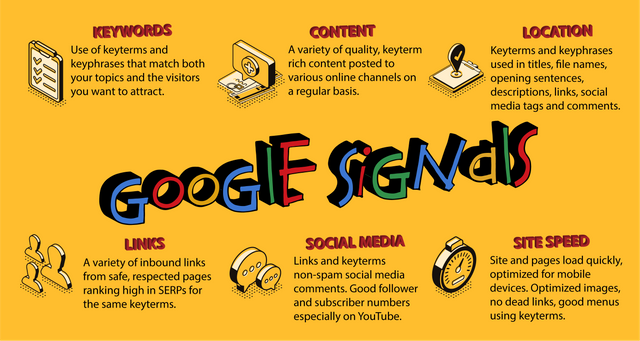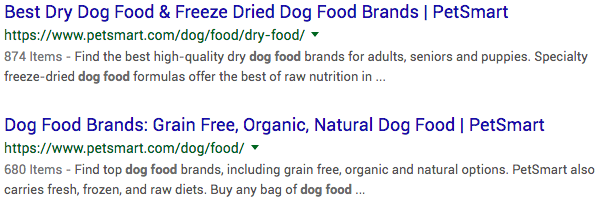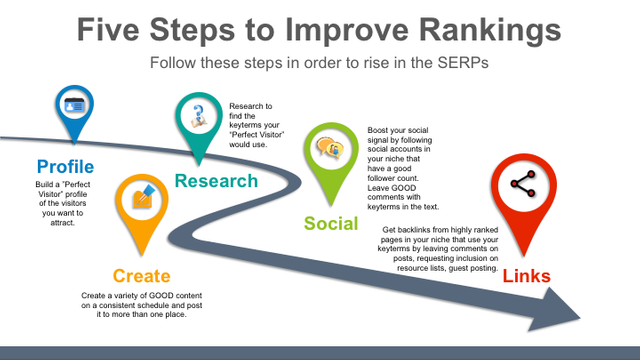To wrap up the Myth, Magic and Mystery of SEO series let’s do a summary of what SEO is all about, the Cliff Notes cheat sheet of SEO.

Courtesy of Pixabay
First thing to remember - SEO isn’t really hard, and if done right it will not be affected by Google algorithm changes or take a ton of money and time.
SEO should be a part of every single thing you do online. Every piece of content, every description, every page of your site - everything. It is the cornerstone of your marketing efforts.
Google is the giant in SEO sending at least 35% of all traffic to successful sites and pages, no matter what that site or page is about.
The Prime Directive for Google is
To present the search visitor with a list of the sites and pages that will best answer their search query.
How does Google fulfill this Prime Directive? By sending the Google Bot to search for signals from web pages that match a complex algorithm buried deep within the bowels of Google. When the right signals are discovered, Google rewards the site and pages that sent those signals with a high ranking on the Google search pages - a Search Engine Ranking Page or SERP - every time a Google visitor types in that search term or a variation of that search term.
What are these signals?
Google looks for much more than just dropping in a search phrase every few sentences on your front page or blog article. In fact, if the search term isn’t in the right places and is used in an unnatural way - repeated frequently where it doesn’t fit the words and phrases around it - it will be seen as keyword spamming and you will be punished and dropped onto page 999 of the SERPs.

Here’s the list of signals that Google looks for in order of importance:
- FRESH RELEVANT CONTENT - don’t just put out a website with pages that never change. Add a blog. Post to it on a regular schedule - at least once per week.
- A variety of content - Google LOVES YouTube! Post videos to YouTube and use your keyterms in the title and description along with a link back to your blog page or website.
- Keyterms used in the right places - Use your main keyterm in your blog title, your video title, name your image files with a keyterm, use it in descriptions, in Social Media comments, in your links and of course in your text - especially in the first sentence or two.
- Write your content for PEOPLE not BOTS - don’t write articles and descriptions the way you think a bot would like to see them - keyphrase another keyphrase some other words keyphrase repeated. Write NATURALLY - for your audience, for your perfect visitor.
- Incoming links - You are ranked by the company you keep - the higher ranked a website or page is for your keyterm the more keyterm “juice” it will pass on to you. Try to get links coming to your pages from pages and websites that are highly ranked for your keyterm.
- Keyterms in links - using a keyterm or phrase on both inbound and outbound links strengthens the signal sent to Google
- Keyterms in the menu structure - name your categories with keyterms, and use them for page titles on a website where ever possible.
- Social Media - Links and comments in social media on accounts and posts that are in your categories, use your keyterms and have a good number of followers/subscribers. Do not spam!
- Keytags - using your primary and secondary keyterms in the keytag area of Steemit, Steempeak, Medium, YouTube - anywhere that allows the use of keytags
- Site Speed and Performance - this is actually the #1 thing Google looks for, BUT it is also something you probably have no control over unless you have your own website and hosting.
Keywords
There is a truism in marketing that goes like this “When you try to sell to everyone you end up selling to no one” (and we don’t mean Arya Stark’s alter ego). Before you do any keyterm research you must identify WHO you want to get in front of. The keyterms that will attract one group of people may be totally useless for another group.
Regional differences and word use must be taken into account. For example, in parts of the U.S. carbonated beverages are called “pop”. In other parts of the country they are called “soda” and in still others they are called “coke”, even if they’re a Pepsi product! Targeting a global market of visitors can be even more difficult with spelling as well as word use variations.
Google looks at the keyterm root, so a plural variation of a keyterm does not need to be placed in a tag area along side the singular variation. If you’ve only used the singular form, visitors typing a plural form will still see your page.
Social Media Signal
Google places great emphasis on social media, especially YouTube. The more people are talking about your page or site, the more attention Google will pay to that page or site.
Social Media signals don’t just rely on your social media accounts, but also look at any comment with your page url AND the keyterm or phrase that may show up in anyone else’s account.
DO NOT USE DRIVEBY SPAM COMMENTS TO GET YOUR URL INTO A COMMENT
Don’t post something like “nice article, here’s another one http:/mysite.com” That’s spam, and the account holder will hate you for it. It will also be ignored by most readers. Google will give you a little credit for it, but you really get SEO “juice” from the shares and clicks that come from a url embedded in a post or comment that has your keyterm(s) in it.
So even a comment left on YOUR social media page that incorporates keyterms will help boost your social media signal.
Influencers
The most popular buzzword in social media these days is “influencer”. Influencers are being dropped by the big companies that used to give social media accounts with large follower bases all sorts of freebies because those “influencer” accounts aren’t moving product. “Influencers” will probably do you no good whatsoever.
Google wants to see shares, clicks on urls, and engagement. They don’t care about “reach” - only uninformed client who don't’ understand how the internet really works pay attention to “reach” (or “influencers” for that matter). Just because someone has a million followers doesn’t mean you’ll get more eyeballs on your comments, in fact the opposite is probably true. On FB, Twitter and IG, accounts with a huge number of followers often move so fast that your comment will be buried among hundreds of other comments before any engagement can happen.
Look for accounts that have a smaller number of followers or subscribers or group members. An account where you can actually get some traction and interaction, generally something in the 30-60K range can be good. Look at the post comment numbers - you don’t want hundreds of comments, you won’t be seen. Something with 20-50 is a good range for interaction and Google love, although even fewer can work out quite well for a well written comment to get interaction.
Links
You are known by the company you keep. You want inbound links - those coming from other websites and pages - to come from respected, high trafficked, sites that also use your keyterms. Some of the best of these carry the .lib (library), .edu (education) or .gov(government) domain extensions. These sorts of sites carry instant authority and will pass some of that on to you if there is a link on their site to your page.
Other sites work to boost your Google Love, too. Sites that use your keyterms, are highly ranked in the SERPs and have a good deal of traffic are what you want to look for. If you get a backlink from a spammy site - get rid of it! You WILL be punished for garbage site links.
There are three ways to get good backlinks.
- Have good, fresh content that another website WANTS to link to and share with their visitors.
- Email the site owner or webmaster and ask to be included, especially if they have a resource page on their site.
- Volunteer to write a guest post on their blog or site.
Leave a GOOD comment on their articles, videos or in their onsite forum. News sites are especially good for this technique. Use your keyterms as well as your url in the comment.
Descriptions and Article Abstracts
It is vital to your SEO efforts to use keyterms in your descriptions and any article teaser text (sometimes called the abstract). Carefully construct your first two or three sentences to include your keyterms AND to attract the interest of the reader. Look at any SERP page and you will see where that text will appear on the search results.

Do not EVER leave the video description field blank, or with only a few words. Try to use 200-300 words in that video description, and include your url as well as your keyterms.
Images
Name your image files with a keyterm or phrase.
Keep image file sizes small to help speed the load time of the page.

In summary - here’s the steps to take, in order, to improve your rankings.
- Build a profile of your perfect visitor - the visitor you want to attract
- Do keyterm research to find the keyterms that perfect visitor would use to find your content. This is more important than how many other sites are using those keyterms, or how many searches that term got last month.
- Create GOOD content on a regular basis - keep it fresh. Put a variety of that good, fresh content in more than one place. Use your website (if you have one, it’s optional for some things) WordPress, Medium, YouTube, Pinterest, InstaGram, FaceBook, and others in addition to Steemit, Steepshot, or Musing. Put your content in the places where your perfect visitor hangs out.
- Boost your social signal by following and leaving GOOD comments that include your keyterms and url when possible, and encourage engagement.
- Get backlinks from respected,high trafficked, well ranked (for your keyterms) web properties by leaving post comments, contacting the site owner and requesting addition to their resource lists, volunteering to guest post.
Do these things, and you will go up in the rankings without spending a ton of time or money. You will also help Steem by reaching conventional internet eyeballs who may not know about Steem, but will see the value in your content (because they found you on Google) and find that Steem is a pretty awesome place to spend some time.
For more detailed information on The Myth, Mystery and Magic of SEO - check my blog for the rest of this 12 part series. Here are a few of the links:
Some Previous SEO Articles in This Series
The Myth and Magic of SEO
The Marketing Mindset
Keywords - Part 1
Keywords - Part 2
Keywords - Part 3
Keywords - Part 4
Backlinks
OnPage Links
Social Media Demographics
Nice to find another SEO on steemit, I have another blog where we post about SEO and if you're keen to guest post let me know! We're always looking for new bloggers to share there thoughts
Downvoting a post can decrease pending rewards and make it less visible. Common reasons:
Submit
Thank you for the invite! And nice to meet a fellow SEO techy type. Can you drop the link to the blog you're doing so I can follow it easier? Thanks!!!
Downvoting a post can decrease pending rewards and make it less visible. Common reasons:
Submit